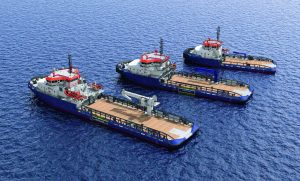New Series of Ice Class Vessel Design
 Today, research and exploration activities in northern regions are increasing, resulting in a growing demand for Ice Class vessels, capable of withstanding the harsh arctic circumstances. Dutch company Offshore Ship Designers (OSD) now meets this demand with new series of Ice Class vessel designs.
Today, research and exploration activities in northern regions are increasing, resulting in a growing demand for Ice Class vessels, capable of withstanding the harsh arctic circumstances. Dutch company Offshore Ship Designers (OSD) now meets this demand with new series of Ice Class vessel designs.
The designs are especially suited for marine services on the development of new arctic ports, terminals, and offshore structures. A prerequisite for this type of vessel operating under arctic conditions, is the ability to deal with the presence of first-year or floating ice, cold conditions, and less developed shore facilities. Apart from the vessels’ capacity to perform their specific tasks, other typical design requirements include increased strength, special installations for tank heating and winterisation, high manoeuvrability, and limited draft. This new series is a result of OSD’s extensive experience with the development of the shallow-draft anchor-handling tug supply vessels called Arctic and Antarctic for Ark Shipping. Both Arctic and Antarctic were designed in close cooperation with the owner, and have a Bureau Veritas 1A Ice Class Notation. The vessels are fully equipped to operate in the challenging and extreme conditions of the Caspian Sea, where ice formation of around 80cm during the winter period is not exceptional.
Herm Jan de Vries, Technical Manager at OSD, explains, “We have incorporated feedback from our clients into the designs. The suggestions made by Ark Shipping based on daily practice experience with the Arctic and Antarctic, were valuable input for our new OSD ice class series. They are a response to identified market needs, covering a variety of tasks such as supply of bulk and break cargo, towing, anchor handling, ice management, personnel transfer, environmental clean-up, and safety/standby duties. To meet these diverse roles, the propulsion plant of the vessels can be adapted to suit the operational profile.” Options include the installation of controllable-pitch or fixed-pitch propellers, with or without nozzle, driven by a diesel direct, hybrid or full diesel electric power plant. The use of podded propellers is also possible. An optimal performance can now be achieved in various conditions such as maximum bollard pull, higher speed-transfer duties, slow speed duties for ice management or stand-by duties. The designs are available in three different lengths of 50m, 65m, and 80m, with a bollard pull ranging from 45 up to 70t.






